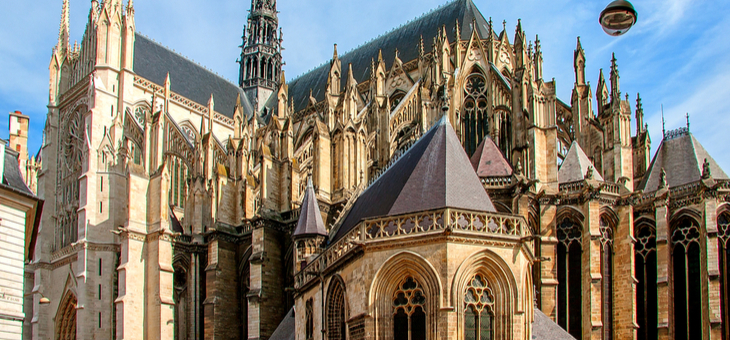Elizabeth Quinn is a writer, francophile and single mother of three young adults. She knows the value of support networks after almost losing her life in a car accident 10 years ago – on the day she planned to leave her marriage. Her website, diywoman.net, was created to provide a similar support network. There, she writes from practical experience about issues of interest to people over 50. Today, she recounts her Anzac Day-inspired journey to France and to Amiens Cathedral.
•••
The cathedral at Amiens is a soaring Gothic monument that was once a place of pilgrimage.
In the early 13th century, it was thought to house the skull of St John the Baptist. In 1218, a lightning strike of biblical proportions destroyed both the church and its content. The construction of a new church began in 1220. Despite fire, faulty engineering, revolution and two world wars, it has survived intact for the past 800 years.
Another kind of divine intervention – this time benign – saved the cathedral from ruin during World War I. Amiens station was an important supply hub for troops and equipment across the Somme, and therefore a prime target for the Germans. Several bombs were dropped on the cathedral, some left unexploded for weeks until they could be safely removed and detonated. On the request of Pope Benedict XV in July 1918, the German forces were persuaded to stop bombing the church. It was a rare show of humanity towards the end of an otherwise unchivalrous war.
My grandfather was one of the young Australian men who fought in the Somme in World War I.
It was his first trip overseas; a boy’s own adventure that soon turned to horror in the muddy fields of a strange country. The only time he spoke to my father of his time in the war was to praise the beauty of the Amiens cathedral. He would have been one of the men described by English war correspondent Philip Gibbs as “Australians and New Zealanders, unfamiliar with cathedrals and not religious by instinct or training [who] wandered round in a wondering way…”. My grandfather would never have seen anything like it back home in Preston.
Gazing heavenward towards the vaults of the cathedral on Anzac Day last year, I shared his feelings of awe. It was 100 years since he visited the site, shortly before the mustard gas attack that saw the end of his active service in France. It was also the first anniversary of my father’s death.
I had stayed up all night to attend the dawn service at the Australian War Memorial just outside Villers-Bretonneux in an unsuccessful attempt to reconcile the two events a century apart. Nothing that was said by the Australian politicians and military men struck a chord with me. French Prime Minister Edouard Philippe got closest with his focus on the youth of the Australian troops. Their wide-eyed innocence was captured in large black-and-white projections on screens above our heads. A welcome respite from the seemingly endless speech-making.
We are not a God-fearing family, but in the sweeping proportions of the cathedral, there is a hint of the power of faith.
I lit a single candle for my grandfather and his son – my dad. I had brought a personal offering, too. It was a small sprig of rosemary from my mother’s garden. For its resting place, I had in mind the iron bracket of the marble plaque dedicated to the Australian soldiers who defended France. It was just out of my reach.
My gaze alighted on two young Australian men inspecting the crosses marked on the floor tiles, each one designating an unexploded German shell. I introduced myself and told them about my rosemary. Liam, the taller of the two, shoved it into the bracket for me. Jack told me they were best friends from Sydney, on exchange to French universities. They were 21 years old; best mates on an adventure far away from home and family. Just like all those young men whose photos I had seen projected onto buildings and giant screens throughout the long cold night and into the grey dawn.
Suddenly, inexplicably, I was near to tears.
I understood why I was in Amiens Cathedral on the anniversary of my father’s death; the centenary of his father’s repatriation. I was there to honour the memory of a man I never met, who left home at 23 to fight a war in another country. I was there to grieve for a father who – at the age of 18 – lost his father to long-term lung damage caused by mustard gas attack. Two fine young men both, forced to grow up too soon. This cathedral had brought together three generations of my family under one magnificent roof. And, strangely, that was enough.
This piece was first published in The Sunday Age.
Related articles:
Finding your inner eccentric
The memory keeper
Who gets custody of the friends?

